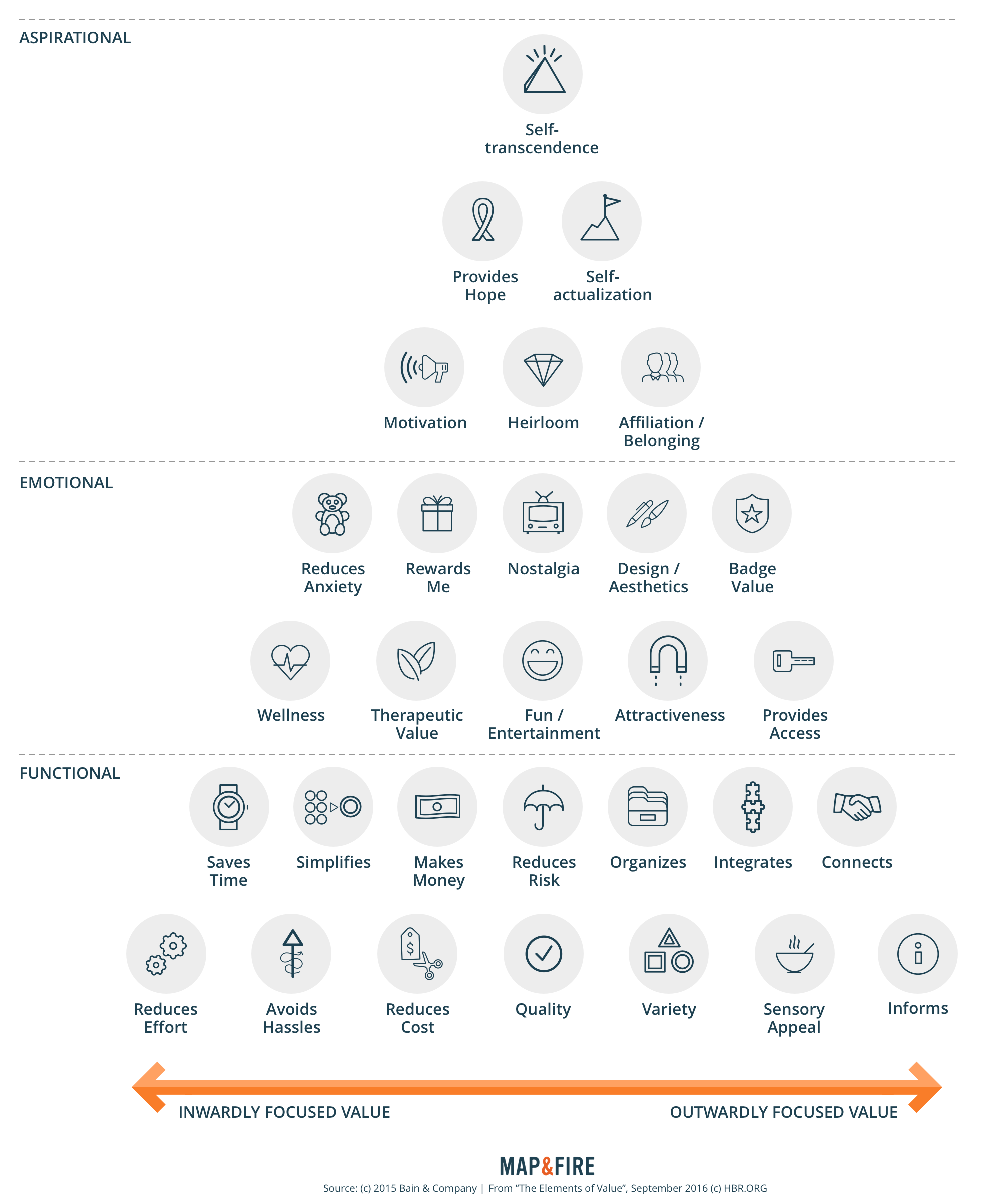Brand and Marketing Field Guide: Customers
How well do you really know your customers’ needs and priorities?

Customer Definitions & Examples
Our Content Is Featured In:

Join 5,887 folks who receive our latest insights and you'll get immediate access to our 10 page brand strategy workbook!
Jobs to Be Done
A Job to Be Done is defined as the progress that a person is trying to make in a particular circumstance (Competing Against Luck by Clayton Christensen). There are two key parts to this definition:
The progress is important because it represents movement toward a goal or aspiration. Jobs are an ongoing struggle for progress, not simple tasks to be completed. It can be helpful to think of this “progress” as a combination of what the Customer wants, and why they want it.
The circumstance is essential to defining the job (and finding a solution for it), because the exact kind of progress desired always depends on a person’s circumstances. As a simple example, “eating a satisfying meal” means something very different when you’re on a date vs. when you’re at the airport vs. when you’re running late to a meeting.
We don’t “create” or invent Jobs for our Customers. Instead, we discover them by listening to the struggles of real people with real problems (often through interviews, for example).
Jobs are enduring and persistent throughout our lives, but the way we solve them can change dramatically over time.
For example: “deliver a package from point A to point B” is a timeless job that has been fulfilled in different ways as technology advances: Walking, to Pony Express to FedEx to Drones. Likewise, “communicate with coworkers” is a timeless job that has been fulfilled by private meetings, phone calls, registered mail, email, text messaging, Skype, Slack and more. Businesses will continue to find new and better ways to fulfill these jobs, but the Jobs remain.
Successful products/services help Customers fulfill important Jobs in their lives. They enable progress, resolve struggles, and fulfill unmet aspirations. In short, they meet real needs.
In contrast, unsuccessful offerings are generally those that fail to connect with important Jobs for their target customers. They may provide distraction, novelty, or a “different” or “better” way of doing things that doesn’t meaningfully improve the Customer’s solution to their Job.
This is why we start with the Problem (the Customer Job) before we decide on a solution (the Offering). This ensures that we’re focused on providing value by solving a real problem, and that even if our initial Offering doesn’t work, we can simply try a different approach because we’re confident that we’re solving a problem that is real.
Remember: Customer Jobs are enduring, but the way we solve them changes.
Fall in love with the problem, and you can explore many possible solutions.
Click here for our complete Jobs to Be Done section with exercises, examples, and more.
Read our articles on Jobs To Be Done:
5 Steps That Will Get You From Business Idea to Launch (Step 2: Customer Jobs)
Jobs Stories
We use a highly structured format for capturing these Job Stories. It has 3 parts: Situation, Motivation, and Expected Outcome.
With our Job Stories, we’re trying to capture the story of your customers in their moments of struggle or desire for progress.
Job Stories Helper Questions
Here are the kinds of questions to consider (and ask your customers) to uncover Job Stories:
Questions to Uncover Job Stories
1. What progress is that person trying to achieve?
- What are they trying to change or improve in their lives?
- Why do they want to achieve it?
- How will their lives be better as a result of making their desired progress?
2. What are the circumstances of the struggle to make progress?
- Who are you? Who is with you?
- What are you doing? What were you doing earlier? What will you be doing next?
- What time of the day is it?
- Where are you?
- What social, cultural or political pressures exert influence on you?
3. What obstacles are getting in the way of the person making that progress?
- Are finances a limiting factor?
- Is timing, or time of day an issue?
- Are there access-related obstacles, e.g. with location, technology or information?
- Are there physical, social or emotional obstacles?
4. What are their current solutions?
- Are your customers making do with an imperfect solution?
- Are they compensating in other areas?
- Are they cobbling together workaround solutions with multiple other products?
- Do they choose to do nothing at all, and simply leave their job unfulfilled?
5. How do they define “quality” or “success” when it comes to this Job?
- What are their top priorities?
- What aspects of the solution do not matter to them?
- What trade-offs will they accept to achieve progress in the way that they want?
Elements of Value

Much like Maslow’s Hierarchy of Needs represents the tiers of motivating psychological factors for people in their day-to-day lives — the Elements of Value outline similar motivating factors but focused more specifically around business needs.
The concept was presented by the consulting group Bain & Company to help isolate the 30 most basic things that a customer might care about (and be willing to invest money or time) when using a product or service.
We use these Elements of Value to create an Offering that will best satisfy a Customer’s Job to be Done.
Watch our video on the Elements of Value:
How to Create a Unique Brand Using The Elements of Value
Read our article on the Elements of Value:
How to Find the Peaks, Pits, and Potholes In Your Brand
Jobs to Be Done vs. Personas
Many companies use detailed customer profiles (“Personas”) to describe their target audience. These can be useful — but in practice they often end up stuck on the shelf.
Here’s why: Personas focus on description rather than causality. They paint a convincing picture of a target customer, but they don’t reveal Why that person would choose your offering over a competing alternative.
Personas: “Here’s an example of the kind of person who is we want to choose our product.”
Jobs to Be Done: “Here’s the situation our target customer encounters in their lives that could cause them to use our product.”
The difference is subtle, but extremely important. Personas describe a Person, and Jobs describe a situation that causes that Person to do something. When it comes to understanding our competition and designing an offering that fulfills a specific job and meets a specific need, we get much more mileage from the Job to Be Done. That’s why we use Jobs to Be Done as our primary tool for understanding Customers.
Jobs are inherently complex: they have functional, emotional and social dimensions.
Based on what you know of your Target Customers, list their top 5 Jobs below. Then rank how important this job is to your customer, and how often they need to accomplish it.
Many questions could be asked in defining the circumstances of a job:
- Where are you?
- When is it?
- Who are you with?
- While doing what?
- What were you doing half an hour ago?
- What will you be doing next?
- What social, cultural or political pressures exert influence?
The notion of a circumstance can also include other contextual factors, such as:
| Life Stage | Family Status | Financial Status | Many More… |
| Just out of college | Married / Single / Divorced | Underwater in debt | Just moved to new city |
| Stuck in midlife crisis | Newborn / young children | Breaking even | Traveling abroad |
| Nearing retirement | Caring for adult parents | Ultra-high net worth | Changing Careers |









